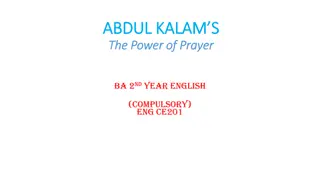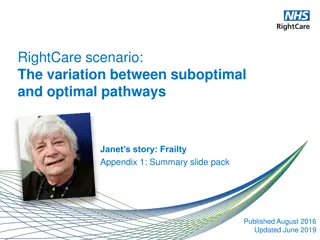Abdul's Journey: Contrasting Standard and Optimal Healthcare Pathways
Abdul's story illustrates the stark contrast between a sub-optimal healthcare pathway, leading to chronic kidney disease and multiple complications, and an optimal pathway where early detection and intervention improved his prognosis. Neglecting follow-up appointments and ignoring symptoms resulted in a series of health crises for Abdul, culminating in his premature death, highlighting the critical importance of timely medical attention and adherence to treatment plans in chronic conditions.
Download Presentation

Please find below an Image/Link to download the presentation.
The content on the website is provided AS IS for your information and personal use only. It may not be sold, licensed, or shared on other websites without obtaining consent from the author.If you encounter any issues during the download, it is possible that the publisher has removed the file from their server.
You are allowed to download the files provided on this website for personal or commercial use, subject to the condition that they are used lawfully. All files are the property of their respective owners.
The content on the website is provided AS IS for your information and personal use only. It may not be sold, licensed, or shared on other websites without obtaining consent from the author.
E N D
Presentation Transcript
NHS RightCare scenario: The variation between standard and optimal pathways Abdul s story: Progressive Chronic Kidney Disease Appendix 2: Short summary slide pack January 2018
Abdul and the sub-optimal pathway (1) Abdul, is 30 years old, married with two young children. A healthy young man with no major illnesses in his childhood, he enjoys football, running, and walking with his family. A health check at work revealed that Abdul had blood and protein in his urine and he was treated for a urinary tract infection. He had no symptoms and soon after moved house and did not make any further appointments with his new GP. At the age of 40, Abdul was invited to attend his GP health check at work and was noted to have high blood pressure. In the absence of any other cardiovascular risk factors he was advised to return for a repeat test. As he felt well he did not follow this up. At 44, Abdul visited the GP with a chest infection. Oral antibiotics did not resolve it and he required a hospital admission; he was told that he had suffered from acute kidney injury secondary to the underlying pneumonia. Follow up blood tests were advised after four weeks but again he failed to make a follow up appointment. He began to feel more tired, took less exercise and began to gain weight. Age 48, Abdul was admitted to A&E feeling weak and breathless. His blood pressure was 190/126. His eGFR was 7 and his Hb was 83. He spent 48 hours in the local hospital Intensive Care Unit. He was informed there was no chance of kidney recovery since kidney disease had been present for many years. He was transferred to the local renal centre and advised to start dialysis. 2
Abdul and the sub-optimal pathway (2) Abdul later developed an infection related to his catheter and he had to be readmitted to hospital. This was now having a real and negative impact on his mental wellbeing and his work. After extensive investigations he underwent an operation to replace his aortic valve and bypass a blocked coronary artery. Six months following his heart surgery he had stabilised and was once again active, but was forced to take early retirement. During the following six months he had admissions with fluid overload and a chest infection but he was activated on the cadaveric deceased organ transplant list. He also underwent a course of much needed counselling After two years on the waiting list he was offered a deceased donor transplant at the age of 53. The transplant functioned reasonably well after a period of three weeks in hospital and he was discharged. Sadly, at the age of 55 he suffered a stroke and two months later he died from a heart attack. He left behind his wife and two children who remember their father as someone who was unwell for the last 10 years of his life. 3
Abdul and the optimal pathway (1) When Abdul s health check at work revealed that he had blood and urine present in his urine, his GP was notified. Abdul s GP outlined the follow up tests that he would recommend, plus impressed the importance of follow up testing. The GP was concerned by the FU results and explained the implications( Teachback technique) including the potential diagnosis of CKD. He was seen in the Renal Outpatient department at the hospital three weeks later, where these results were confirmed and he underwent an ultrasound of his kidneys, which was normal. After careful consideration and discussion, Abdul consented and a kidney biopsy was carried out. IgA Nephropathy was then confirmed. The diagnosis was clearly explained and advice and support offered. Abdul was placed on the Chronic Kidney Disease (CKD) Register at his GP practice and was seen on a regular basis by the GP Practice Nurse; he continued to be reviewed every six months in the nephrology clinic with satisfactory blood pressure control. Over the next ten years Abdul managed to maintain a healthy lifestyle. However, his renal function continued to deteriorate despite good blood pressure control. 5
Abdul and the optimal pathway (2) At the age of 44 Abdul became unwell with a chest infection and went to see his GP. He was treated at home initially with oral antibiotics. Because of his underlying renal disease his GP recognised the risk of developing AKI and so kept a close eye on Abdul. Abdul did need to go to hospital but did not need dialysis (due to the close monitoring by the GP). At the age of 52, his renal function had deteriorated such that Abdul's care was transferred by the renal unit to the low clearance clinic so that he could receive formal education regarding the options for renal replacement therapy. After careful consideration with his wife and the rest of his family Abdul decided that he would like to receive a renal transplant. (This was not an easy decision when explained that Black Asian and Minority Ethnic (BAME) patients face a number of challenges with receiving a kidney transplant.) His wife was not found to be a match but Abdul s brother was screened and he turned out to be compatible. At the age of 54, he underwent an elective living donor renal transplant. His operation went smoothly with immediate transplant function and he was discharged after seven days. His brother also recovered well. Two years later he remains well, has become a grandparent and continues to work as the manager of his local Ford garage. 6
Financial information As can be seen from the table, secondary care expenditure in the two scenarios is radically different. Acute costs in the optimal case represent less than 18% of the original sub-optimal case, equating to a reduction of more than 230k. Primary care expenditure is necessarily higher in the optimal scenario as the optimal case invests in primary care monitoring. Please note the financial costs are calculated on a cost per patient basis and local decisions would need to take a population view of costs and improvement.
Financial information In the sub-optimal pathway Abdul s care was over-reliant on secondary care and was not sufficiently managed in primary care or at home. Improved management had a dramatic impact on him and family life. Such costs are difficult to quantify, but are very real. Not only is Abdul s health and quality of life much better in the optimal scenario, the cost savings are significant. 8
Further information For more information about Clara s journey, NHS RightCare or long term conditions you can: Email rightcare@nhs.net england.longtermconditions@nhs.net Visit www.england.nhs.uk/rightcare Tweet @NHSRightCare 10























